
Abstract
Aims: Reports of long-term outcomes of patients treated with drug-eluting stents in total coronary occlusions are limited. We analysed clinical outcomes of patients treated with the zotarolimus-eluting Resolute stent (R-ZES) implanted in coronary total occlusions versus non-occluded lesions.
Methods and results: Patients treated with R-ZES and included in four trials (RESOLUTE All Comers, RESOLUTE International, RESOLUTE China RCT, and RESOLUTE China Registry) were pooled and divided into three groups – patients with chronic total occlusions (CTO), patients with total occlusions that had occurred recently (rec-TO), and patients without total occlusions (non-TO). Clinical outcomes at five years were analysed. Of 5,487 patients treated with R-ZES in these trials, 8.0% had CTOs, 8.5% rec-TOs and 83.5% non-TOs. Patients had a mean age of 62.8 years, approximately 25% were female and 30% were diabetics. TLF was similar in the three groups at five years (TLF was 13.2%, 12.5% and 13.3% in the CTO, rec-TO and non-TO groups, respectively, p=0.96). Stent thrombosis tended to occur more frequently for rec-TO compared to CTO and non-TO patients (2.6% vs 1.2% and 1.3%, respectively, p=0.11).
Conclusions: In this large population of patients who had R-ZES implanted, five-year clinical outcomes were similar whether or not the stents were implanted in total occlusions.
Introduction
Patients with occluded coronary arteries may have clinical symptoms ranging from stable angina to acute coronary syndromes. Whereas lesions that are not totally occluded (non-TO), in addition to those occluded recently (rec-TO), rarely represent technical challenges unless containing a heavy thrombus burden, percutaneous coronary intervention (PCI) in those with chronic total occlusions (CTO) is obtained with varying technical success1. Implantation of a drug-eluting stent (DES) improves outcomes including the occurrence of restenosis in patients with coronary total occlusions2,3, despite a higher occurrence of stent strut malapposition4. We have previously reported favourable two-year outcomes in patients with both CTO and rec-TO in comparison with those with non-TO lesions treated with the Resolute™ zotarolimus-eluting stent (R-ZES; Medtronic, Minneapolis, MN, USA)5. We found the incidence of stent thrombosis (ST) highest in patients with rec-TO, probably due to a higher level of thrombogenicity in these patients who often present with acute coronary syndromes.
The R-ZES has previously been demonstrated to be clinically safe and effective compared with other drug-eluting stents6,7,8,9. However, reports of long-term outcomes in patients with recanalised total occlusions appear to be limited, especially with the use of second-generation DES. Patients with rec-TO often have acute coronary syndrome, and from a patient population of two trials we have previously reported a slightly higher occurrence of ST in patients treated with PCI and R-ZES implantation for rec-TO when compared with both patients with CTO and those without an occlusion5. Based on the patient-level pooled data from four prospective trials and registries, our study aimed to assess the long-term safety and efficacy of second-generation R-ZES in the treatment of CTO lesions.
Methods
STUDY DESIGNS AND POPULATIONS
Our data are derived from the RESOLUTE All Comers trial, the RESOLUTE International trial, the RESOLUTE China Randomized Controlled trial (RCT) and the RESOLUTE China Registry, all registered with ClinicalTrials.gov (numbers NCT00617084, NCT00752128, NCT01334268 and NCT01243749, respectively). All trials evaluated clinical outcomes of patients with significant coronary artery disease treated with PCI including R-ZES implantation with annual clinical follow-up.
RESOLUTE All Comers is a randomised multicentre trial primarily evaluating clinical outcomes up to five years after implantation of R-ZES versus an everolimus-eluting stent in an unselected cohort of patients representing a variety of coronary artery disease (n=2,292)5,10. A fraction of the patients (20%) had a 13-month coronary angiography performed. The RESOLUTE International trial is a worldwide multicentre observational registry of clinical outcomes of unselected patients three years after implantation of R-ZES (n=2,349)11,12. RESOLUTE China RCT is a randomised trial comparing five-year clinical outcomes of an all-comer Chinese patient population, who have either an R-ZES or a paclitaxel-eluting stent implanted (n=400). The study included coronary angiography at nine months13. RESOLUTE China Registry is a multicentre observational registry study of clinical outcomes from unselected patients who have an R-ZES implanted and are followed for five years (n=1,800)14.
PROCEDURES
Patients were treated with dual antiplatelet therapy for at least six months according to current international guidelines. PCI was performed in accordance with local standard techniques aiming to cover (≥2 mm on each side of) the culprit lesion from healthy-to-healthy vessel with a stent with a final residual diameter of <25% by post-dilatation using non-compliant balloons.
All patients were included after written consent, and the local ethics committees approved the respective studies, that were all conducted in accordance with the Declaration of Helsinki.
ENDPOINTS AND DEFINITIONS
CTO was defined as a total occlusion with Thrombolysis In Myocardial Infarction (TIMI) grade 0 blood flow with estimated duration of at least three months prior to the index procedure. Rec-TO was defined as a recently (<3 months prior to PCI) occluded lesion with TIMI 0 blood flow. The RESOLUTE All Comers study did not collect the timing of CTO, so patients with a total occlusion were included in the CTO group if they had no recent myocardial infarction and in the rec-TO group if they had a recent myocardial infarction. Patients in all studies who were not categorised as CTO or rec-TO were considered non-TO.
The primary endpoint of the present analysis was target lesion failure (TLF), defined as the composite of cardiac death, target vessel myocardial infarction (TVMI) and target lesion revascularisation (TLR) recorded at follow-up. Secondary endpoints included the components of the primary endpoint and the rate of definite and probable stent thrombosis. Independent site monitoring was performed in all studies, and clinical events committees adjudicated the endpoints.
Deaths were considered cardiac unless an unequivocal non-cardiac cause was documented. Target vessel MI was defined as an MI clearly not located in a non-target vessel, and TLR and target vessel revascularisation as clinically driven PCI or coronary artery bypass grafting of the culprit lesion or vessel. Definite and probable stent thromboses were adjudicated in accordance with the Academic Research Consortium15.
STATISTICAL ANALYSIS
Data from patients who had an R-ZES implanted in the two randomised trials and data from all patients included in the two registries were pooled. The pooled data were divided into three groups according to the presence and duration of a total coronary occlusion.
Categorical data among groups were compared using the chi-square test, and continuous variables with the Student’s t-test. Survival curves were created using Kaplan-Meier estimates, and the log-rank test was used for comparisons between groups. A two-tailed p-value <0.05 was considered significant.
Results
Of the 6,841 patients included in the four trials, 5,487 had at least one R-ZES implanted. Among the lesions treated with R-ZES implantation, 436 (8.0%) were CTOs, 467 (8.5%) were rec-TOs, and 4,584 (83.5%) were non-TOs. Three-year follow-up data were available for 97% of patients in the RESOLUTE International trial, and five-year data were available in 98% of patients in the remaining trials.
The baseline demographic and angiographic data of the patients and procedures are presented in Table 1 and Table 2. Non-TO patients were slightly older with fewer stents implanted (especially compared to the CTO group). The majority of rec-TO patients had acute coronary syndromes (78.4%) and fewer cardiac risk factors except for diabetes. The non-TO group had significantly fewer lesions treated per patient and a significantly smaller total stent length per patient compared to the rec-TO and non-TO groups. Otherwise, no relevant differences were found among the three groups.
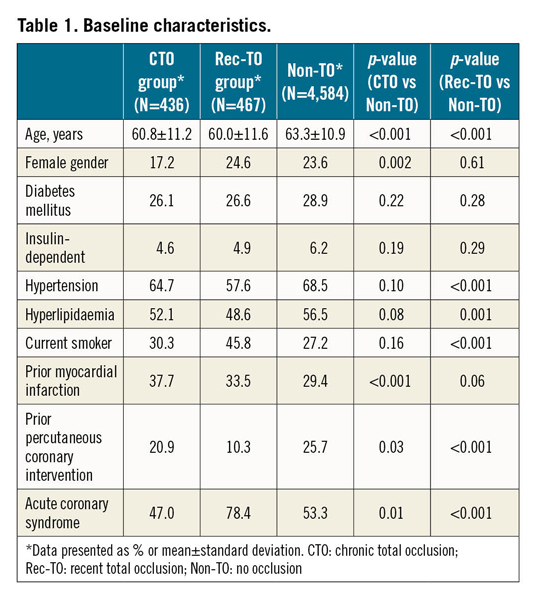
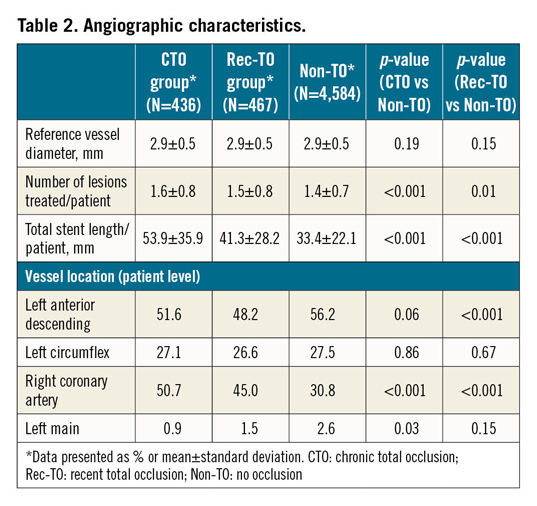
At five-year follow-up, there were no differences in the incidence of the primary endpoint (Figure 1) or its components (Figure 2) among the three groups: TLF at five years was 13.2% for CTO, 12.5% for rec-TO and 13.3% for non-TO patients (p=0.96). There was also no difference among the groups in secondary endpoints measured at five years (Table 3). Most stent thromboses occurred relatively early. The rate of ST levelled off after 12 months and was generally low, with a non-significant numerically higher incidence occurring in the patient group with recently occluded vessels (p=0.11) (Figure 3).
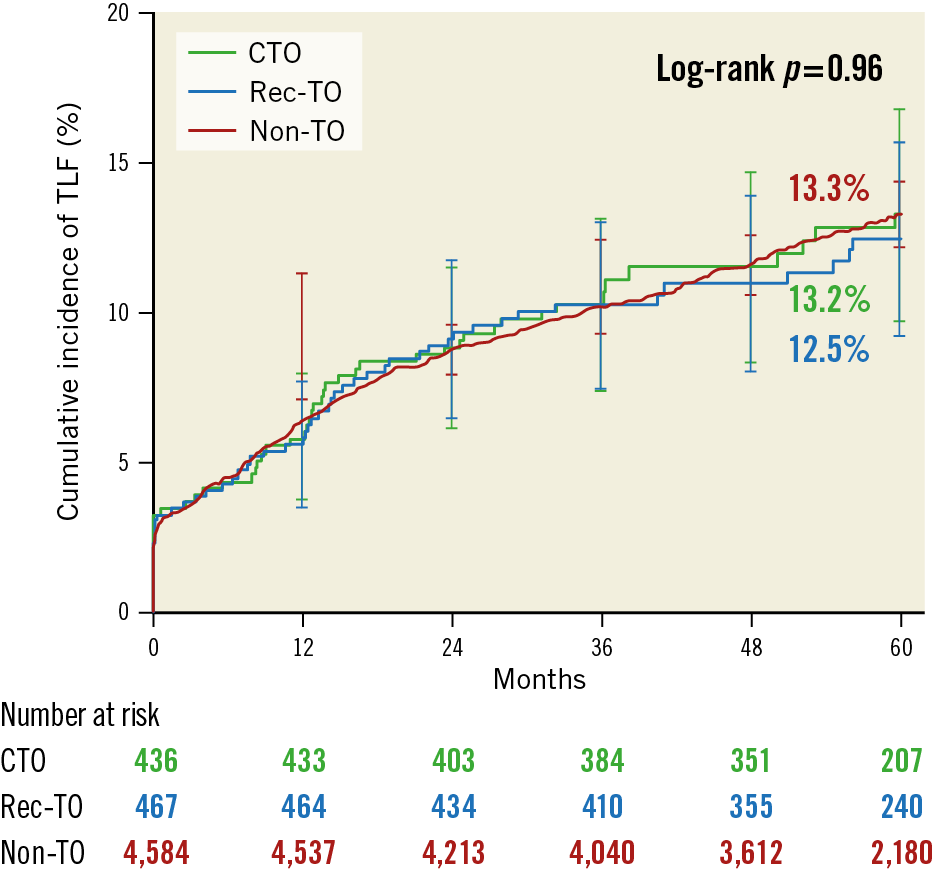
Figure 1. Cumulative incidence to five years for target lesion failure. CTO: chronic total occlusion; Non-TO: not totally occluded; Rec-TO: recent total occlusion; TLF: target lesion failure
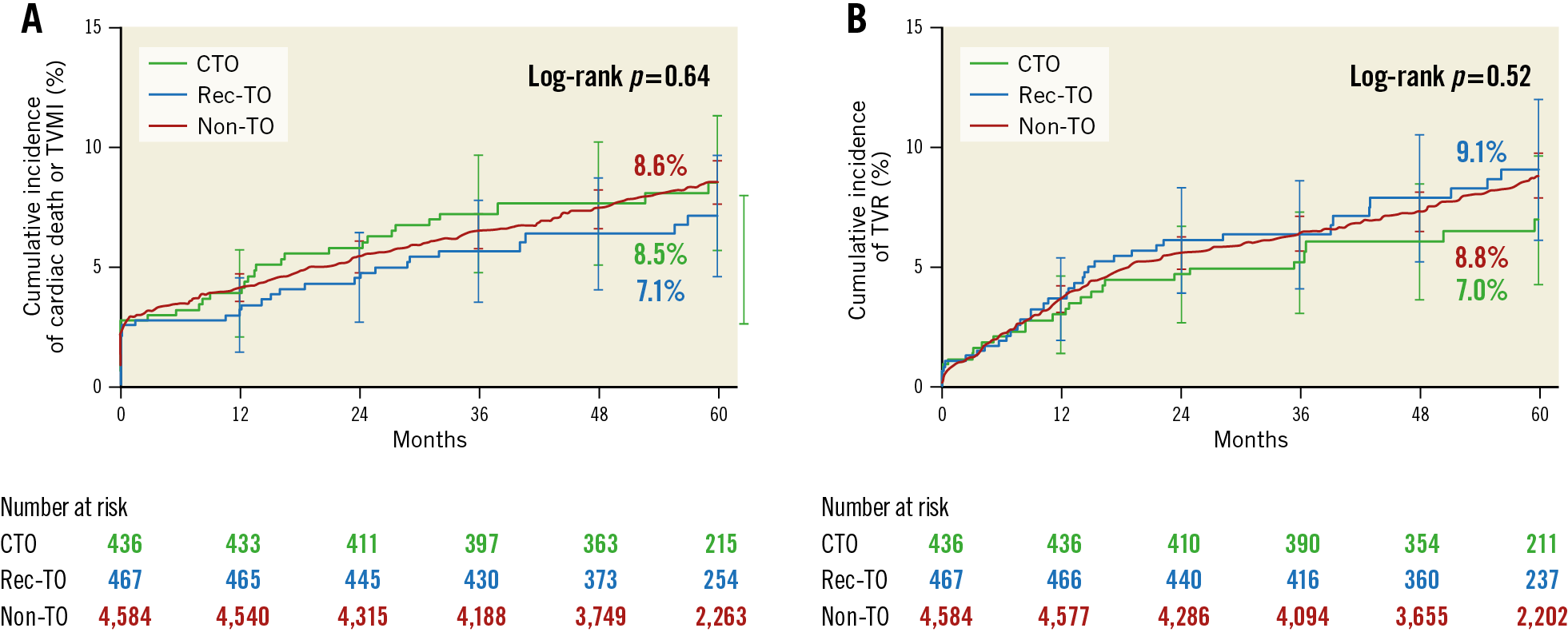
Figure 2. Cumulative incidence to five years for cardiac death or TVMI, and TVR. A) Cardiac death or target vessel myocardial infarction. B) Target vessel revascularisation. CTO: chronic total occlusion; Non-TO: not totally occluded; Rec-TO: recent total occlusion
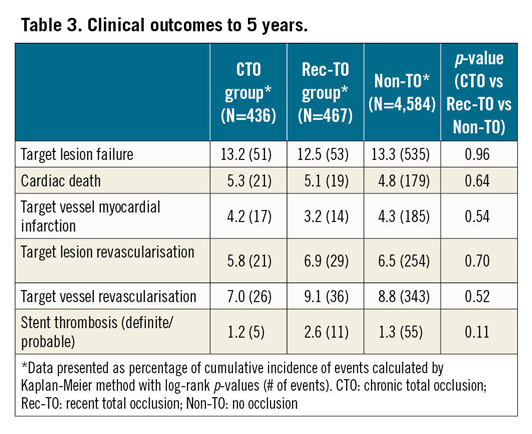
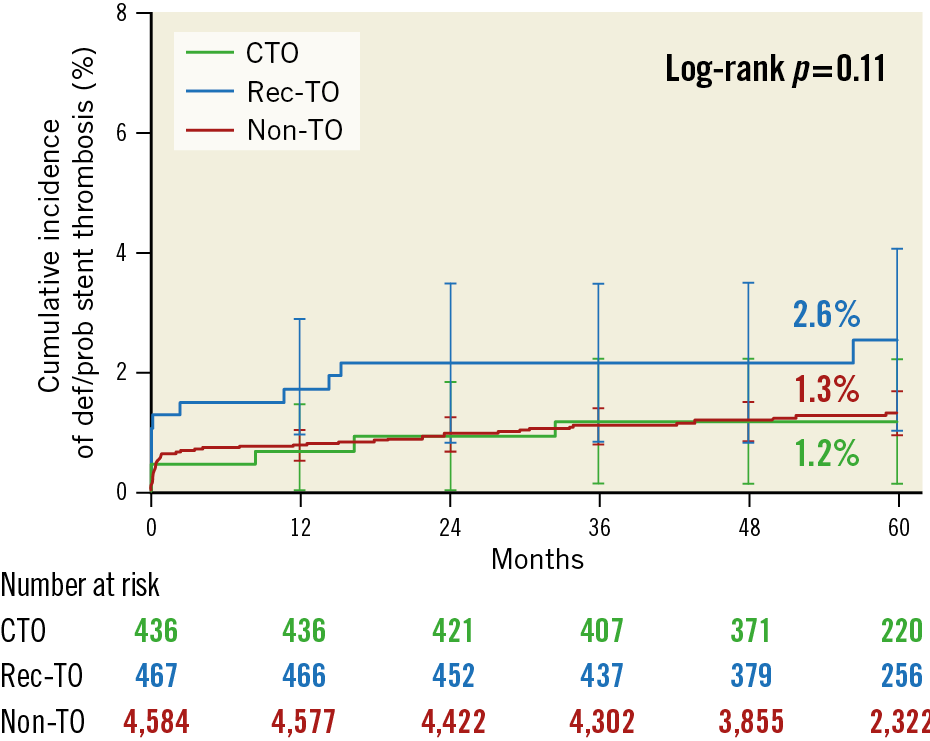
Figure 3. Cumulative incidence to five years for stent thrombosis (definite/probable). CTO: chronic total occlusion; Non-TO: not totally occluded; Rec-TO: recent total occlusion
Discussion
Patients treated with R-ZES in their recanalised CTO lesions had low five-year rates of the primary endpoint of target vessel failure (TVF), despite longer stent length, smaller stent diameter and higher mean number of implanted stents and, as an unexpected finding, we were able to report almost identical TVF rates in patients with CTO and non-TO. Treatment of CTOs with R-ZES was safe with a very low five-year rate of ST, that was almost identical to that of patients without CTO. The rates of cardiac death and TVMI were also low and did not differ significantly in patients with CTO versus patients with non-TO. Probably due to the thrombogenic environment, rec-TO patients, mostly in the setting of acute coronary syndrome (3/4 of the patients in this group), had low albeit numerically higher rates of ST compared to patients in the CTO and non-TO groups.
Although the safety of PCI treatment including implantation of DES in patients with acute occlusion of a large coronary artery presenting with ST-segment elevation myocardial infarction has been investigated in long-term follow-up trials16,17, treatment of patients with coronary occlusions of longer duration remains a matter of debate. Only a small number of randomised comparisons of clinical outcomes between patients treated with optimal medical therapy versus CTO revascularisation have been performed18,19,20.
Randomised studies comparing DES and bare metal stent implantation in recently occluded coronary arteries or chronic total coronary occlusions are also scarce2,21,22, as the initial pivotal trials of DES did not include patients with complex lesions. Because of the high rate of restenosis in patients who had a bare metal stent implanted, especially in total occlusions, the use of DES in recanalised total occlusions would be expected to provide a considerable advantage by reducing the risk of restenosis and the need for repeat revascularisation. Later registries including first- and second-generation DES have confirmed the safety and efficacy of stents in recanalising total coronary occlusions.
The rate of ST in this analysis was low, considering the fact that all studies contributing to the pooled results included unselected patient populations. We have recently reported favourable outcomes of patients who had R-ZES implanted in all-comer patients and in patients with total coronary occlusions5,7. In patients with total occlusions, the rate of definite and probable ST was higher in patients with recent occlusions, interpreted as a consequence of an increased thrombogenic nature of these lesions. This trend is seen in the present trial, although it did not reach statistical difference (Figure 3).
The present study describes long-term outcomes of patients with a variety of clinical conditions treated with R-ZES and compares patient outcome in those treated for non-occluded versus occluded target lesions. Both the level of TLF and the occurrence of ST reported in our study, especially late ST, are considerably lower than long-term reports after implantation of first-generation DES in all-comer populations23,24. This reduction may reflect that the excessive inhibition of neointimal growth seen after implantation of first-generation stents causing delayed vascular healing was modulated by introduction of new DES. The balance between complete neointimal stent strut coverage and hyperplasia has been optimised over the years, using stents with thinner struts and altered drugs and drug release characteristics. So, while previous studies of first-generation DES have reported a constant occurrence of ST up to 10 years after PCI, the levelling off of ST over time, as demonstrated in the present study, may represent an effect of the above-described combination of both an improved stent design including altered drug kinetics and thinner stent struts in comparison with the original DES25,26. The impact of a biodegradable polymer, originally created to reduce the risk of ST, is still a matter of debate, because long-term follow-up of patient cohorts with these stents implanted is still outstanding27.
There is recent evidence of a lack of association between interrupted dual antiplatelet therapy and development of ST with the use of newer DES28,29. However, because of the very low level of ST observed in the present study, we are unable to draw any conclusion about an association or lack of connection between ST and interrupted antiplatelet therapy. Indeed, shortening of the duration of dual antiplatelet therapy seems safer after implantation of newer DES compared with first-generation DES.
Limitations
The current analysis was not pre-specified. The RESOLUTE International trial followed patients up to three years, whereas the other three trials followed patients to five years. All patients in the RESOLUTE China RCT and 20% of those in RESOLUTE All Comers had angiographic follow-up at 9-13 months.
Because we only report clinical outcomes in patients with recanalised vessels, our clinical outcome results cannot be extrapolated to a general population of patients with CTO. On the other hand, the total stent length in our CTO patients (median length 42 mm) indicates that the lesions were not simple to treat.
Our results originate from pooled data from two randomised trials and two registries, all of which had independent monitoring, that was probably most thorough in the randomised trials, especially with regard to screening of patients for eligibility. Enrolment in the RESOLUTE All Comers trial was close to 50% of all patients treated with PCI at the participating centres; we expect this percentage to have been even higher in the remaining three studies, especially the registries. So, patients were not entirely treated by experienced operators. Still, a certain selection bias towards a favourable outcome in the overall enrolment cannot be ruled out, and our results should be interpreted accordingly. In addition, more research is warranted to focus on the impact of zotarolimus versus other -limus drugs on the beneficial outcome in patients with occluded coronary arteries treated with PCI.
As previously mentioned, incomplete revascularisation of patients with CTO is associated with an increase in future events, especially new or repeat revascularisations. We were not able to report the more patient-oriented endpoint of all-cause mortality, or any MI and revascularisation, known to occur approximately twice as often as our primary endpoint of TLF.
Conclusions
Long-term TLF was similar in patients with both rec-TO and CTO lesions compared with patients with non-TO lesions, suggesting that R-ZES implantation is safe and effective in patients with total occlusions.
|
Impact on daily practice Our results indicate that patients who have their occluded coronary artery recanalised and the Resolute zotarolimus-eluting stent implanted have the same long-term clinical outcome compared with those who have this stent implanted in non-occluded vessels. Whether this applies to all new-generation coronary stents is unknown. |
Guest Editor
This paper was guest edited by Alec Vahanian, MD, PhD; Department of Cardiology, Hôpital Bichat-Claude Bernard, and University Paris VII, Paris, France.
Acknowledgements
The authors thank Sandeep Brar, MD, and Lisa Bousquette, MS, for contributions to study management, and Beth Ferri, PhD, CMPP, for editorial support, all from Medtronic.
Funding
The trials pooled in this post hoc analysis were funded by Medtronic.
Conflict of interest statement
H. Kelbæk has received research grant support from Medtronic Inc. R. Yeh has received grant support/research contract/consultant fee/honoraria/speaker’s bureau from Abbott Vascular, Abiomed, Boston Scientific Corporation, Medtronic Inc, Asahi Intecc and Teleflex. F.-J. Neumann reports grants from Medtronic, during the conduct of the study, personal fees from Amgen, AstraZeneca, Bayer, Boehringer Ingelheim and Daiichi Sankyo, grants and personal fees from Pfizer, Biotronik, Edwards Lifesciences, and Bayer Healthcare, grants from Medtronic, Abbott Vascular, GlaxoSmithKline, and Boston Scientific, and personal fees from Novartis, Ferrer, and The Medicines Company, outside the submitted work. P.W. Serruys has received consultant fee/honoraria/speaker’s bureau from Abbott Vascular, Biosensors, Medtronic, Micell Technologies, Sino Medical Sciences, Philips Volcano, HeartFlow, Xeltis, and Sahayanand Medical Technologies (SMT), outside the submitted work. S. Windecker receives research and educational grants to his institution from Abbott, Amgen, BMS, Bayer, Biotronik, Boston Scientific, CSL Behring, Edwards Lifesciences, Medtronic, Sinomed and Polares. M. Liu is an employee of Medtronic Inc and owns Medtronic stock. The other authors have no conflicts of interest to declare. The Guest Editor is a consultant for Edwards Lifesciences.
Supplementary data
To read the full content of this article, please download the PDF.

